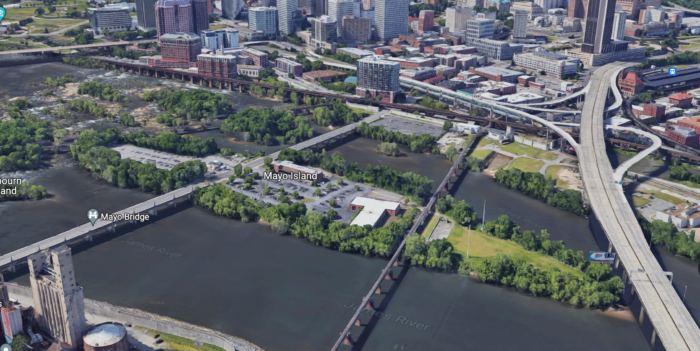A lawsuit centered on Mayo Island has been squashed ahead of the island’s pending sale and as preparations continue to replace its namesake bridge.
A Richmond Circuit Court judge has dismissed a lawsuit filed by the island’s current owners against VCU and the state, court documents show.
The dismissal, which came on April 10, ties up a loose end ahead of Mayo Island’s planned $14.9 million sale to the City of Richmond, which is working with the Capital Region Land Conservancy to acquire the 15-acre island and turn it into a park.
The Shaia family owns the majority of Mayo Island and filed the lawsuit against VCU shortly after listing the property for sale last year.
The Shaias alleged that the university hadn’t paid rent on a parking lot it leased on the island and sought over $240,000 in damages. VCU argued, in court documents, that the island’s owners failed to meet certain terms of the lease, allowing the university to terminate the lease in 2021.
At a January hearing, the two sides argued their cases to Judge C.N. Jenkins Jr., who initially ruled in VCU and the state’s favor. A month later the Shaias filed a motion to reconsider, but after a second hearing on April 10, Jenkins again ruled in favor of the university and dismissed the case with prejudice.
Thomas Shaia of Shaia’s Law was representing the island’s owners and declined to comment.
Two weeks after the case was dismissed, Richmond City Council passed an ordinance to accept $7.5 million in state grant funding to be put toward the purchase of Mayo Island. CRLC, a local nonprofit, secured the grant funding on the city’s behalf late last year.
At the time, CRLC had the island under contract for $11.8 million, but the arrangement has since changed and the City of Richmond is now the contract purchaser.
CRLC executive director Parker Agelasto, a former city councilman, said CRLC is still closely involved with the project, namely in helping the city fundraise an additional $2.5 million for the purchase. CRLC also will be the holder of the conservation easement that’s expected to be placed on the island, an agreement that would preclude the property from future development.
Agelasto said such factors make this deal an atypical real estate transaction.
“You’re dealing with state grant money, municipally owned land, grants that require conservation easements, and private philanthropic dollars that can go toward acquisition and the restoration of the island,” he said.
“It’s a very complicated structure, but that’s what you have to do in order to try to accomplish something as significant as (acquiring) Mayo Island.”
Since the city took over as the purchaser, Agelasto said a roughly half-acre plot on the island’s eastern tract that was not part of the original deal has been added. That parcel is currently owned by Alan and Wayne Shaia directly, as opposed to the Mayo’s Island L.C. through which the family owns the rest of the island.
Another quarter-acre sliver of the island at 510 S. 14th St. that’s used as a food truck court is not part of the sale to the city.
Meanwhile, the state and the Virginia Department of Transportation are preparing to replace the 110-year-old Mayo Bridge due to structural deficiencies.
VDOT is leading the bridge replacement project, which is budgeted to cost $90 million. The project is scheduled to get underway in 2026 and would close traffic along the bridge for about three years during construction.
A lawsuit centered on Mayo Island has been squashed ahead of the island’s pending sale and as preparations continue to replace its namesake bridge.
A Richmond Circuit Court judge has dismissed a lawsuit filed by the island’s current owners against VCU and the state, court documents show.
The dismissal, which came on April 10, ties up a loose end ahead of Mayo Island’s planned $14.9 million sale to the City of Richmond, which is working with the Capital Region Land Conservancy to acquire the 15-acre island and turn it into a park.
The Shaia family owns the majority of Mayo Island and filed the lawsuit against VCU shortly after listing the property for sale last year.
The Shaias alleged that the university hadn’t paid rent on a parking lot it leased on the island and sought over $240,000 in damages. VCU argued, in court documents, that the island’s owners failed to meet certain terms of the lease, allowing the university to terminate the lease in 2021.
At a January hearing, the two sides argued their cases to Judge C.N. Jenkins Jr., who initially ruled in VCU and the state’s favor. A month later the Shaias filed a motion to reconsider, but after a second hearing on April 10, Jenkins again ruled in favor of the university and dismissed the case with prejudice.
Thomas Shaia of Shaia’s Law was representing the island’s owners and declined to comment.
Two weeks after the case was dismissed, Richmond City Council passed an ordinance to accept $7.5 million in state grant funding to be put toward the purchase of Mayo Island. CRLC, a local nonprofit, secured the grant funding on the city’s behalf late last year.
At the time, CRLC had the island under contract for $11.8 million, but the arrangement has since changed and the City of Richmond is now the contract purchaser.
CRLC executive director Parker Agelasto, a former city councilman, said CRLC is still closely involved with the project, namely in helping the city fundraise an additional $2.5 million for the purchase. CRLC also will be the holder of the conservation easement that’s expected to be placed on the island, an agreement that would preclude the property from future development.
Agelasto said such factors make this deal an atypical real estate transaction.
“You’re dealing with state grant money, municipally owned land, grants that require conservation easements, and private philanthropic dollars that can go toward acquisition and the restoration of the island,” he said.
“It’s a very complicated structure, but that’s what you have to do in order to try to accomplish something as significant as (acquiring) Mayo Island.”
Since the city took over as the purchaser, Agelasto said a roughly half-acre plot on the island’s eastern tract that was not part of the original deal has been added. That parcel is currently owned by Alan and Wayne Shaia directly, as opposed to the Mayo’s Island L.C. through which the family owns the rest of the island.
Another quarter-acre sliver of the island at 510 S. 14th St. that’s used as a food truck court is not part of the sale to the city.
Meanwhile, the state and the Virginia Department of Transportation are preparing to replace the 110-year-old Mayo Bridge due to structural deficiencies.
VDOT is leading the bridge replacement project, which is budgeted to cost $90 million. The project is scheduled to get underway in 2026 and would close traffic along the bridge for about three years during construction.





I keep beating the same drum. Don’t close the bridge for three years to waste nearly $100 million on replacing it with another bridge in the 100 year floodplain. Just close the existing bridge for normal vehicular traffic forever! Use the money to create a center lane for mass transit and for changes on ether side of the river that could divert other vehicles to the underused 18 other lanes of bridge traffic that are within a mile of 14th Street and Hull Street. It’ll resolve dangerous pedestrian issues on both sides of the river in Shockoe and Old Manchester… Read more »
Aren’t they replacing the bridge because it’s becoming structurally deficient?
The pillars are sound. Per the structural engineer, they are good for 400 years! However, they will not be used. The structure itself cannot take the pounding of 20k+ vehicles per day for a long term but that would be eliminated altogether if closed to vehicular traffic. One bus every 15 minutes or so in the center lane? Not a problem.
I wish they would put a bridge over the James from near 360 over to Dock street, or even Main Street.
Closing 14th street bridge permanently? I’m not so sure the new developments south of Mayo would be OK with just a walking bridge. If you want housing and business south of Mayo, you need a road to connect 360 to downtown.
They’d support it. The bus only transport would benefit the community. As of now, the traffic is a hazard.
Interesting idea. I drive that way home from work in the evenings. The intersection of Canal and 14th is atrocious. To make this work, there needs to be some traffic improvements to Hull Street near the flood wall to divert vehicles easily toward Bainbridge onto Commerce or southeast to the I-95 roundabout. Manchester is undergoing a transformation with retail, commercial, office, and residential development. It still lacks a grocery store and my fear is that without a good plan to allow thousands of cars daily to flow in and out, no grocery store would want to build there.
I fully support this idea because as enjoyable as the Mayo Bridge is for walking, it’s dangerous due to how low the curb is and how close the cars are to you. It would be great to put this money towards a new bridge connecting Manchester with Rt. 5 across the River.
With 20k+vehicles per day I would think the city needs that corridor to access Manchester/downtown areas.I can’t see that many walking to a park there.
The Manchester and Lee bridges are so vastly under utilized that there have been proposals floated to convert some of the lanes to pedestrian only access. The roads that access those bridges and I-95 on either side of the river were designed to handle far greater traffic than utilized today but in some cases restricted left turning rules prohibit their use. The cross Manchester traffic is actually funneled to Hull Street. All that will have to change for three years during the construction of a new bridge anyway and the existing bridge will be inaccessible for ALL, including pedestrians while… Read more »